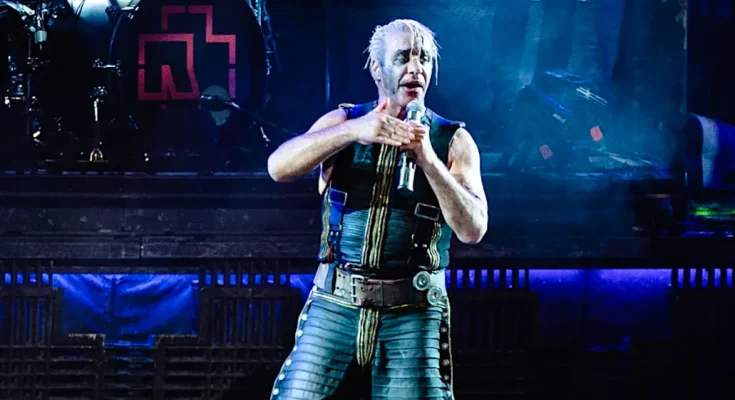It was a night that many in the Rammstein fanbase had been waiting for: May 22, 2023, in Vilnius, Lithuania. That show marked the German industrial metal juggernaut’s first official concert of the year — after a closed, fan‑club-only dress rehearsal a few nights earlier. The atmosphere was electric. The crowd in Vingis Park was primed for a spectacle, expecting the blend of bombast, darkness, theatricality, and raw power that Rammstein has made their signature. But what unfolded in that final moment was something no one quite anticipated: a dramatic fall by their frontman, Till Lindemann, off the edge of the stage.
From what is known, that evening the six members of Rammstein stood at the front of the stage, taking their bows and expressing gratitude to the crowd. They had just delivered a setlist likely to please fans old and new: the band played 21 songs, mixing rarities like “Rammlied” and “Bestrafe mich” alongside staples such as “Du Hast,” “Ich will,” and “Sonne,” and interpolations from their recent works including tracks off Zeit and their unnamed 2019 album
The closing ritual is itself almost choreographed: after the music ends, the band lines up, acknowledges the audience, and then departs, often via stage lifts or platform mechanisms. In past tours, the closing has ended with Till giving thanks before leaving via an elevator or similar apparatus. (Wikipedia) On this night, as Lindemann turned (perhaps to exit or to step toward the vehicle of departure), he lost his footing. Video footage shows him stumbling and falling forward and downward, face-first, into a void behind the stage. (Consequence)
The fall was sudden, caught by fans’ cameras and media outlets alike. One clip published on YouTube shows Lindemann vanishing from view behind the stage edge after turning around and misstepping. (YouTube) Accompanying media commentary described the moment as a “nasty fall,” and reports speculated he tumbled into a gap or opening behind the stage floor. (IMDb) During those first instants, his bandmates, still lined up, appeared oblivious to what had happened. After a second or two, they leaned forward or peered off the stage, trying to discern what occurred.
What followed was tense: would he emerge? Was he hurt? The uncertainty hung heavily over the audience and the internet alike. As some reports noted, for a few long seconds he disappeared from view entirely, vanished into darkness, out of the line of sight of both bandmates and camera angles. (Metal Addicts) Observers later pointed out that the band’s reaction—or lack thereof in the first moment—was telling. Some speculated that in those first seconds, the spectacle and intensity of the show still held everyone’s focus; others suggested the band might have been in the dark about his fall until realizing he was missing. (NME)
Remarkably, Lindemann emerged. According to reports, after a brief disappearance he rejoined his bandmates, ascending by elevator to the upper level of the stage, where he and the rest of Rammstein waved to the crowd and gave their final farewell. (Metal Addicts) That motion suggested he was able to walk or at least move under his own power, and implied that injuries—if any—were not immediately catastrophic. Some outlets said he had possibly sustained a shoulder injury, though that remained speculative. (Reddit) At the time, neither Lindemann himself nor the band issued detailed statements about the severity of his fall or his medical condition. (Revolver)
Photographic galleries and fan videos captured the moment, and the internet buzzed. The fall was replayed, debated, and analyzed. Some fans posted in forums about the sound — a loud thud, possibly amplified by the mic or the stage acoustics. Others noted the sudden, alarming nature of the accident and expressed concern for the singer’s wellbeing. > “That thud, though … I hope he is OK,” one user mused on Reddit. (Reddit) Another fan speculated about a shoulder injury, remarking that Lindemann’s ascent via elevator later suggested he might have dislocated something. (Reddit) Still others reflected on past incidents in the band’s history, pointing out Rammstein’s unsettling rapport with pyrotechnics and stage danger. (Reddit)
Media outlets also revisited Rammstein’s history of stage incidents. In 1996, a section of a set rigging fell during a concert, injuring audience members. The band later addressed it; interestingly, Lindemann subsequently trained in pyrotechnics — partly as a precaution given the band’s frequent use of flames, fireworks, and stage spectacle. (Reddit) That background underscores how Rammstein has always walked a tightrope between theatrical danger and performance.
Returning to the 2023 fall, the incident raises questions about stage safety, spatial awareness, and the unpredictability of live performance. Even in highly choreographed shows—where crew mark stage edges, rig lighting, mark cables, and manage platform mechanisms — the element of human error can still rear its head. That night in Vilnius, the very structure that framed their departure also offered the peril of unseen drops or gaps. Lindemann, perhaps in the rush of adrenaline, perhaps misjudging the edge, fell backward — into the unknown. That he resurfaced suggests resilience, professionalism, and perhaps a dose of luck.
Beyond the immediate spectacle, the fall reinforces how high the stakes are for performers who mix theatrics, darkness, fire, and complex staging. Rammstein’s concerts are not simple rock shows: they are enormous productions, with lifts, scaffolds, hydraulics, explosions, flame hoses, and rigging. The closing moments — the “take your bows and exit” portion — require coordination, awareness, and composure. That Lindemann was able to walk up the elevator and wave suggests that, despite the tumble, the show was not undercut permanently. The band didn’t cancel or ramp down; they finished the ritual. The fact that the fall occurred at the very end likely helped reduce any larger disruption to the performance itself.
From a narrative standpoint, it’s also fittingly dramatic: a rock-star tumble at the climactic moment, disappearing from view and re-emerging like a phantom. For fans and media alike, the visual of a frontman literally dropping offstage is indelible — a reminder of the fragility behind even the most polished spectacle. In the days that followed, tour plans were not altered in public. Rammstein proceeded with shows as scheduled, heading to Helsinki next and running through a European leg with dates across cities like Munich, Madrid, Lisbon, Budapest, Berlin, Paris, and ending in Brussels. (NME)
That continuation suggests that either Lindemann’s injuries were limited, or the band and tour staff managed them behind the scenes. For a band of Rammstein’s scale, medical contingencies, backup plans, and risk mitigation are likely part of every tour. Still, a public fall like that forces the conversation into both technical and human territory: how performers balance spectacle and safety, how audiences perceive danger as part of the show, and how legends continue.
In reflecting on cultural resonance, Lindemann’s fall also echoes an age-old trope: the star who stumbles but rises again. It’s cinematic. It invites speculation, adjustments, scrutiny, and, in some minds, myth-making. Fans poring over slowed-down video clips or analyzing stage diagrams will draw conclusions: Did he misstep? Were lighting or gaps inadequately marked? Was it the pressure of closing, exhaustion, or distraction? Was the elevator positioning too close? And was he lucky or just well-prepared for such an eventuality?
It’s worth noting that Rammstein’s shows often end with high drama. Often, the exit involves pyrotechnics or mechanical lifts. In their tour arrangements, after the curtain falls, the band sometimes re-emerges on elevated platforms to wave and bow, executing a stylistic exit. (Wikipedia) The trick is that those final moments, although seeming simple, require precision: stepping off into darkness, repositioning with limited visual cues, and doing so while fatigued and emotionally taxed. In such conditions, a misjudgment becomes perilous. This makes Lindemann’s fall all the more dramatic.
Journalists and fans continue to revisit the footage. Revolver ran a piece, “See Rammstein’s Till Lindemann fall offstage in Lithuania,” recounting how at the end of the show, during the bowing moment, he misjudged his step backward and plunged off the stage. (Revolver) Later outlets, like Consequence, embedded fan‑shot video and photo galleries, using the fall as an anchor for recounting the show’s arc.NME’s reporting emphasized that the fall occurred “in an opening behind him” — a space not visible to many, and perhaps unexpectedly close. (NME) Metal Addicts noted how Lindemann disappeared from view for seconds, then rejoined, pointing out the drama of his disappearance and reemergence.
Social media reactions included both concern and humor, as fans debated whether the fall was serious or part of some twisted performance art. One Redditor wrote, “The thud is loud, but likely because of the mic picking up a lot of it … nonetheless, I hope he is OK.” (Reddit) Others speculated he might have injured his shoulder, given how he walked into the elevator afterward. Another user noted that in past accidents, the band has shown remarkable composure under pressure. (Reddit) Some reflections weighed the band’s legacy: Rammstein has long courted danger in their performances, to the point where pyrotechnic hazards are intrinsic to their brand. But those same hazards demand that performers respect limits; a fall like this underscores how close to the edge (literally) they operate.
Importantly, by not canceling or postponing subsequent shows, the band implied confidence in Lindemann’s viability. It also prevented the incident from overtaking the tour narrative. Instead, it became a footnote, a dramatic moment that would be woven into the lore of Rammstein’s live mythology. The next shows continued, audiences cheered, and the tour machine rolled on.
In the long run, the fall raises salient points about live performance in the modern era. It emphasizes how performers are bound not only by their instruments and voice, but by the physical spaces they inhabit, the set designs they traverse, and the invisible hazards lurking at each transition. It reminds us that even for veterans who have toured for decades, no matter the technical crew or safety protocols, human error can still exact a visible — sometimes dramatic — toll. It also shows how quickly a momentary lapse can become immortalized by fans, video clips, and internet commentary.
For Till Lindemann, the fall is now part of his live legend. He is no stranger to theatrical risk; through Rammstein’s history he has walked amid pyrotechnics, flames, and danger. But in that moment, he simply misstepped and fell. That he reappeared and the show ended with a bow adds to the narrative of resilience.
The image is cinematic: the rock god stepping into darkness, disappearing, emerging again, waving to the crowd. It underscores how, in live music, the boundary between performance and accident is thin. A misstep can become myth. And for Rammstein, a band whose identity leans into spectacle, that myth becomes part of their ongoing legacy.



